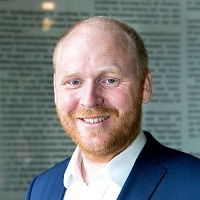 The Swedish firm Fortum Värme has opened up the Stockholm heat grid to producers of heat. They call the concept Open District Heating. This will enable a new market, says Per Gullbrand of the firm who will be one of the speakers on Euroforum’s National Heat Congress on November, 26.
The Swedish firm Fortum Värme has opened up the Stockholm heat grid to producers of heat. They call the concept Open District Heating. This will enable a new market, says Per Gullbrand of the firm who will be one of the speakers on Euroforum’s National Heat Congress on November, 26.
“We encourage companies to sell their leftover heat to us, instead of just letting it go.”
“Stockholm has an infrastructure of 2800 kilometres of pipelines transporting hot and cooled water. This system had been there for decades already and it is functioning well. We transport heat with only a few degrees temperature loss. Now we used to have centralised heat production – only a few energy plants were able to put up heat into this system. Meanwhile there is plenty of waste heat in datacentres for example, that can be used for heating thousands of households.”
What have you done to change this?
“Open District Heating means in a way we changed the system borders for district heating and cooling systems. It was a closed ring with a few producers of high and low temperature, and now we have opened it up. Apart from technical solutions, we have created a set of criteria for these heat producers so they can sell their heat back to us. For example, if they want to sell their heat to us as ‘high quality heat’, it has to be 68 degrees C. We buy it, and use it in our grid for customers who need it.
In Stockholm there are not many big industries. But we do have big data centers and super markets that need a lot of cooling down. As you know, when you cool down something with a cooling machine, you will get heat out of it. We have now made it possible for data centers to get paid for this heat.
For example, in the North part of Sweden there is a big data center that uses lots of energy. And loses a lot of heat. If this data center would move to Stockholm, we could buy its waste heat and sell it for heating thousands of households. For the data center company, this would be both economically and environmentally very interesting.”
Is this for very high temperature only?
“We do not only sell heat, we distribute cooling as well. For example hotels, super markets and ice hockey stadiums need that. For that we have a system of cold transportation. Cold water is sent into the system and it returns to us as warm water. Then we heat it further. So water of 24 degrees Celsius can be high value as well. And you know what? Now that we have opened up our grid for heat producers all over the place, it might be commercially interesting for companies to upgrade their heat to a higher temperature before they sell it back to us.”
And the price of heat will vary?
“It will indeed – on an hour to hour basis. When there is a lot of demand, and production is expensive, we will pay more for the heat we buy. Prices will always be compared to the price we have to pay to produce the same heat. Now for us that will lead to a cost reduction. And the companies that sell their heat to us will get money in exchange for something they would just let slip away otherwise.”
Are there more ways in which this will have an effect on the heat household of companies?
“With the new use of the heat grid it is possible for us to agree on using a company´s existing abundance heating/cooling capacity. Lots of companies have these systems ready, just in case the primary system fails. 99 per cent of the time, these extra systems are not in use. They’re standing and waiting. When we rent their capacity, their owners get more value out of their redundancy. It is more healthy for the equipment as well, because it all needs to run sometimes. Just like an old car standing in the garage, heat systems will get bad unless they are being used.”
So Open District Heating has opened up a vast amount of new possibilities.
“It has indeed. Let me point out one more novelty. In co-location data centers large companies rent data center space for when they need it. These are the large ones, say thousands of square meters. When they are built today, the cooling systems fit the actual number of servers that need to be cooled. If the first client rents only 10 per cent of the space, the temperature system will be built for that 10 per cent. When other clients arrive, the cooling capacity will have to be upgraded and adapted every single time again. Now that we open up the system, these datacenters can build their systems for the full at once, because they can sell capacity they don’t need for the time being.”
You are looking at the end-clients as well?
“A great breakthrough will be when end-clients will ask their datacenters to take better care of their ecological footprint. Such a pressure would make sense: I´ve learnt that every single google search takes approximately as much energy as switching on a 60 Watt light bulb for 15 seconds. The energy used to cool the search database servers now can be re-used.”
How unique is this proposition in the world? And how scaleable is this market?
“It is in fact unique. We are on the same conferences all over the world with innovative companies like Facebook and Google. A lot of industries are interested in these new business models. Theoretically speaking, there is a ceiling in the need for heat – although we are still a long way from there. And other cities in Sweden are building their own heat pipelines now. The main point is that we created a system where heat will no longer be a waste, but a valuable asset that is worth paying for!”
Interested? See more information on www.opendistrictheating.com (www.oppenfjarvarme.se in Swedish) or come listen to him on the National Heat Congress in Utrecht, November 26, 2015.
 Author: Sybren Visser
Author: Sybren Visser
Sybren Visser (1974) is an independant entrepreneurs interviewer. He works as a freelance producer for Dutch BNR Nieuwsradio, congress organization offices, amongst others. Sybren holds a master in Communications Science (department of Linguistics) of Utrecht University.
 Euroforum Blog Het kennis blog van Euroforum
Euroforum Blog Het kennis blog van Euroforum




